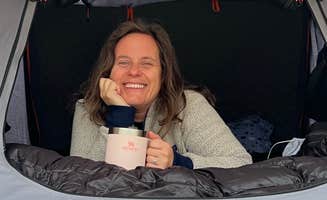Campgrounds near Comstock, Texas lie within the Chihuahuan Desert ecosystem at elevations ranging from 1,000-1,500 feet. The region experiences dramatic temperature variations, with winter nights dropping below freezing while summer days frequently reach 100°F. Gravel and limestone compose most camping areas, creating firm surfaces for tents and vehicles but requiring proper stakes or weights.
What to do
Hiking ancient pictograph trails: At Seminole Canyon State Park Campground, campers can explore prehistoric rock art sites. "We did the rock art/painting guided tour (8.00 per person for adults). Sunsets were beautiful," notes Deborah C., who visited in November 2018. The park offers an 8-mile trail with views of the Rio Grande.
Stargazing on clear desert nights: The minimal light pollution at Governors Landing creates optimal viewing conditions. "Sunsets and sunrises are gorgeous, stars are fantastic," reports Kera P., who appreciated the celestial views despite some highway light pollution. Most campers recommend bringing red-light headlamps for nighttime activities.
Swimming in reservoir coves: During warmer months, the clear waters of Lake Amistad provide swimming opportunities. "Best swimming area is under the bridge," advises Phillip C. about Governors Landing Campground. Water clarity remains exceptional even during lower reservoir levels, with visibility extending 10-15 feet below the surface.
What campers like
Desert ecosystem exploration: The unique plant life surrounding San Pedro Campground provides natural education opportunities. "This park is a confluence of three distinct ecosystems, which makes the flora extra special," explains Shari G. Campers regularly spot desert wildlife including roadrunners, jackrabbits, and occasionally fox.
Convenient location for supplies: Proximity to Del Rio means campers can easily restock necessities. "Del Rio is one of the larger cities along the border between Loredo and El Paso, so there really isn't much you can't get in town just a short drive away," reports Shari G., who stayed at San Pedro Campground. Most campsites lie within 20-30 minutes of grocery stores, hardware stores, and restaurants.
Covered picnic areas with grills: Most established sites include shaded eating spaces. "Each is set up with a grill, picnic table and shade shelter," notes a camper at San Pedro. At Seminole Canyon State Park, campers appreciate the shelters, with Maggie C. stating: "Cactus, no trees, hot sun. This is west Texas! Seriously, it's a nice campground with covered picnic tables."
What you should know
Lake levels fluctuate significantly: The Amistad Reservoir water level changes seasonally and yearly. "The lake as of October 2021 is so dried up you can not see it from the tent sites," reports Stacy M. about San Pedro Campground. During drought periods, boat ramps may be unusable and water activities limited.
Fire ants populate many sites: Common throughout the region, these pests require awareness. "Fire ants EVERYWHERE. We just pitched a tent by the pavilion where we found the least ants," warns Stacy M. after camping at San Pedro. Bringing ant treatment and carefully inspecting tent locations helps mitigate issues.
Highway noise affects some campgrounds: Sites near major roads experience traffic sounds throughout the night. At Governors Landing, "the noise from the highway is quite loud and there's some light pollution from the highway as well," observes Kera P. Sites further from highways, like Rough Canyon, offer quieter experiences but require longer drives.
Tips for camping with families
Choose wind-protected sites: Strong gusts frequently blow through the area, particularly at exposed campgrounds. At Governors Landing, Richard T. experienced challenging conditions: "The winds were so high, the overhang of my roof top tent lifted up taking the ladder up with it. By the way, if you ever get into that situation, tie down your tent to your vehicle."
Visit historical exhibits: Educational opportunities abound at certain campsites. Emily M. recommends: "Cave paintings in the desert. Definitely do the main tour. It's the reason to come here. No trees. The river has carved its way through. Makes for quite a sight when hiking the trails."
Avoid summer with children: The intense desert heat makes family activities difficult from June-August. "Don't do this trip when it's very hot," warns Emily M. about Seminole Canyon. March through May provides more comfortable temperatures for families exploring the outdoors.
Tips from RVers
Solar power works excellently: The abundant sunshine makes alternative power efficient at non-hookup sites. "No electrical hook-ups (bring your solar!), and no water available at this campground," advises Shari G. about Rough Canyon Campground. Most RVers report solar panels providing sufficient power for basic needs during clear weather days.
Level sites require careful selection: While many camping areas appear flat, subtle slopes exist throughout. "The ground is rocky but each of the four campsites had a more or less level spot in front of the covered picnic table," notes Teri S. about Rough Canyon Campground. RVers recommend keeping leveling blocks and studying site layouts before committing.
Water fill stations limited: Potable water access points are concentrated at specific locations. "Drinking water can be filled at the Diablo East Campground dump station, about 4 miles away for no charge," explains a camper staying at San Pedro, highlighting the need to arrive with full tanks or know refill locations.







